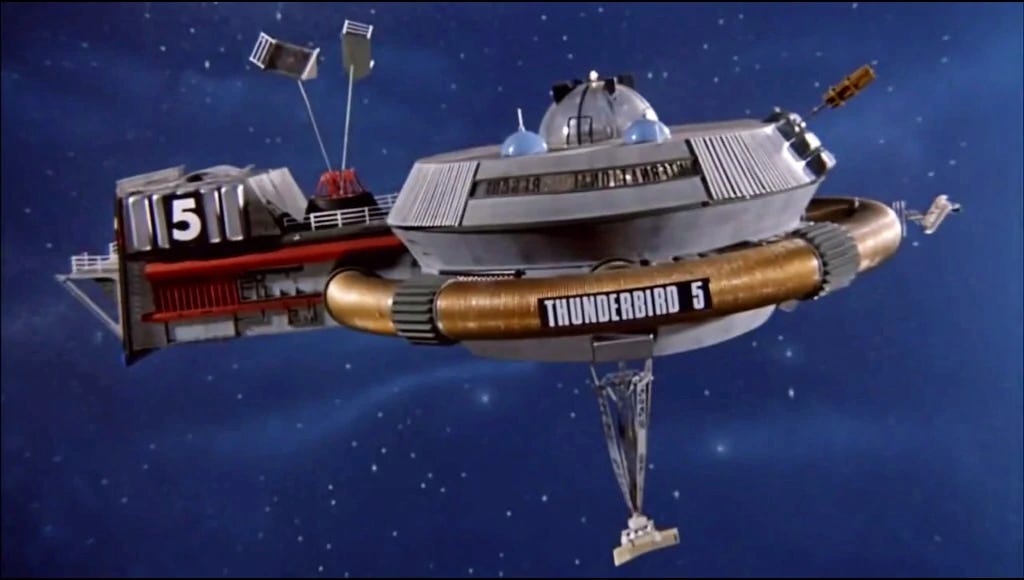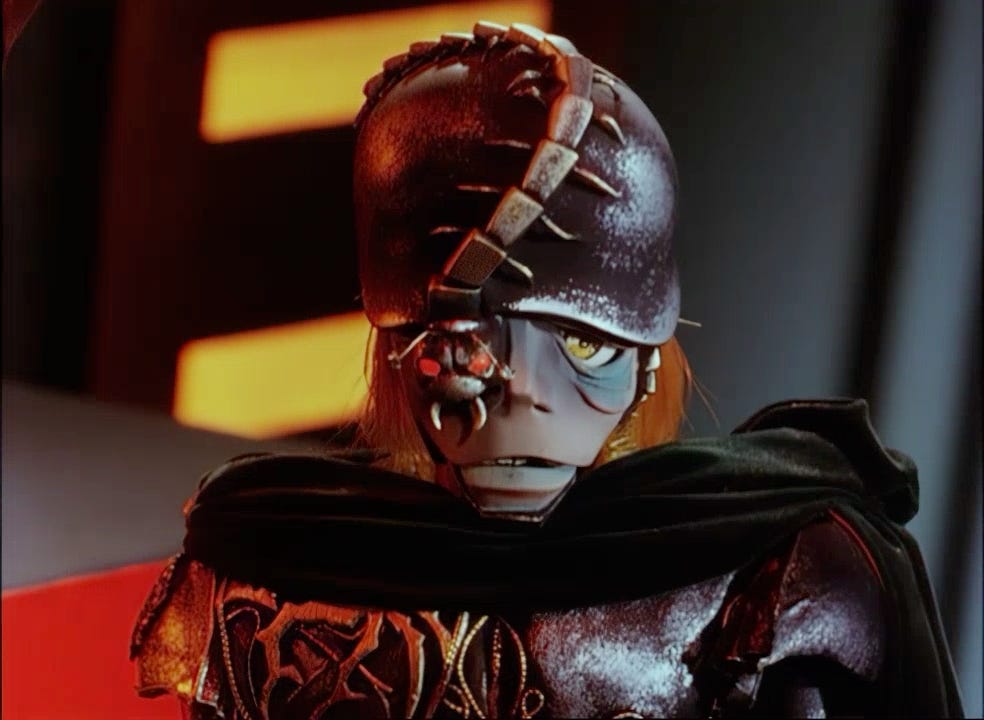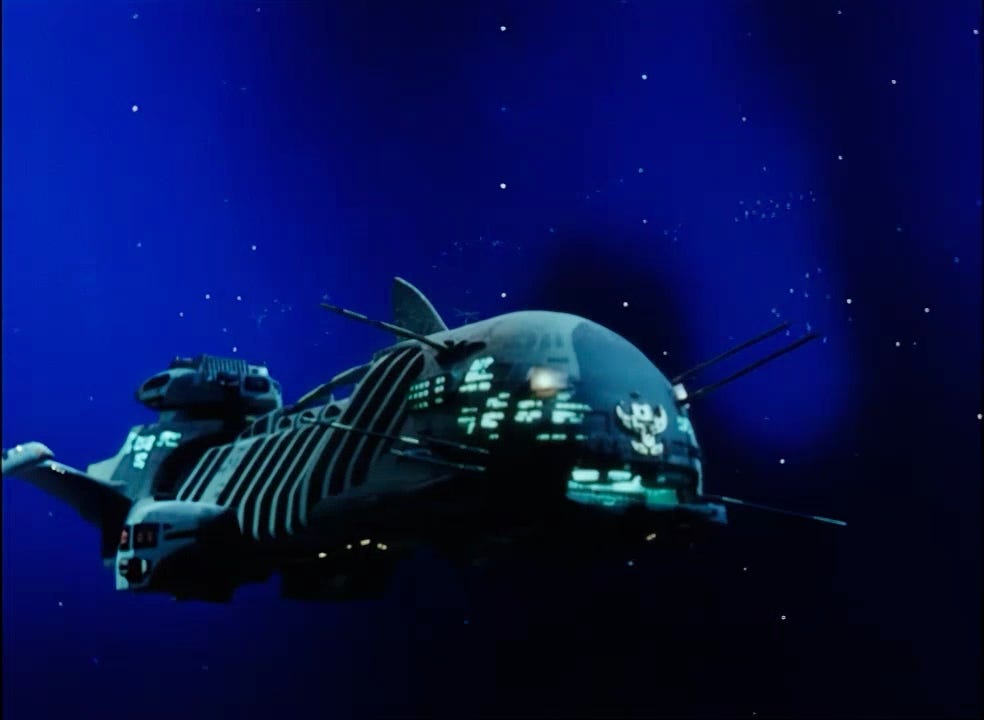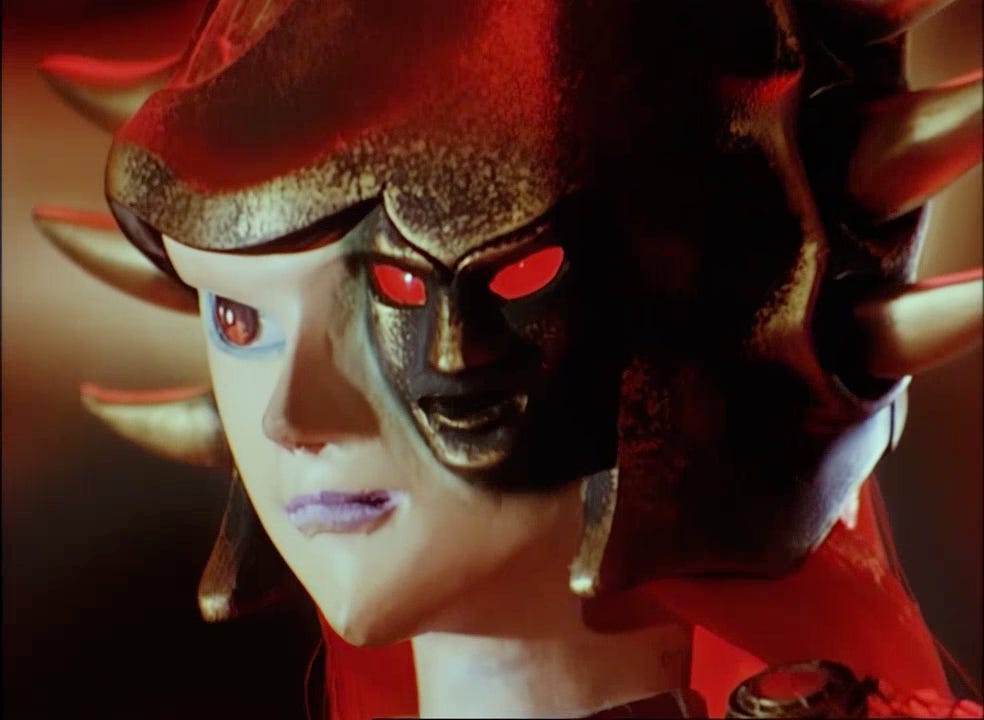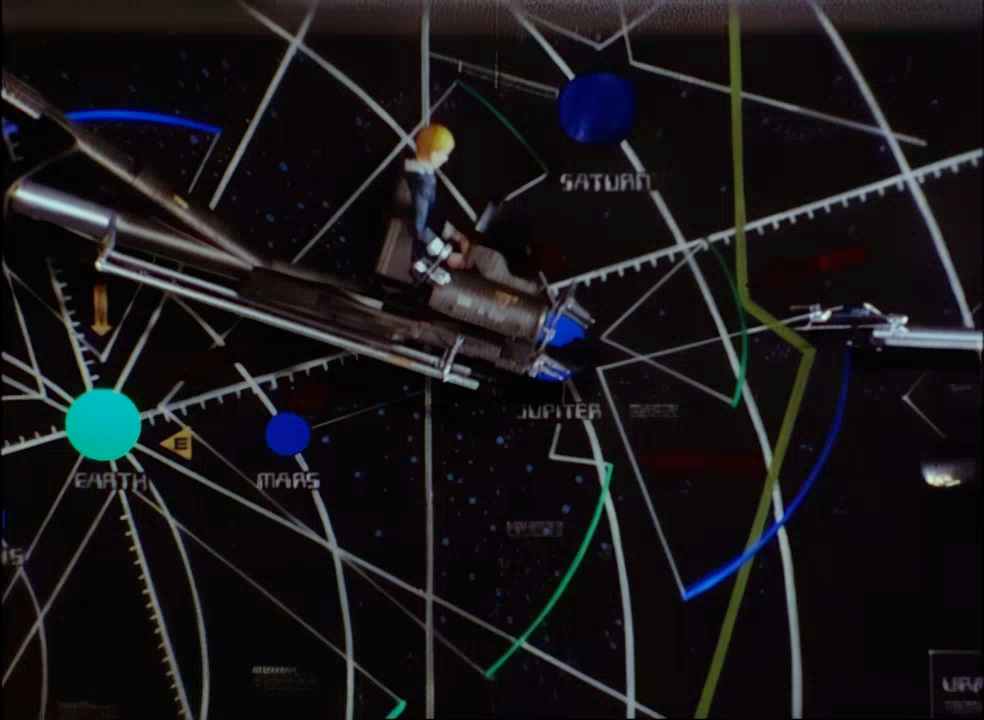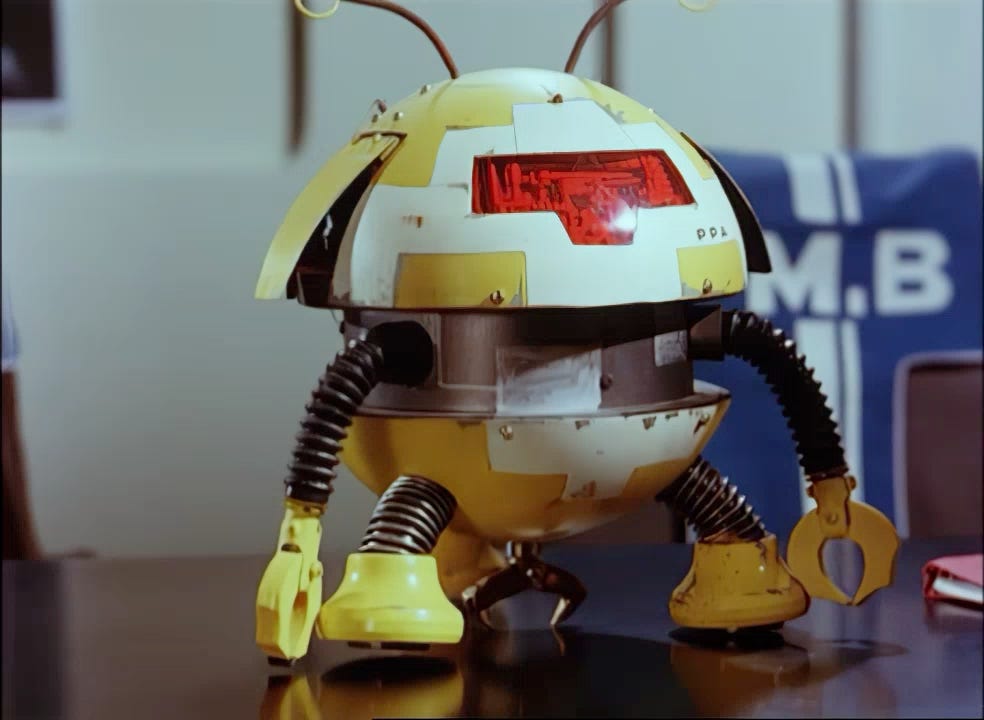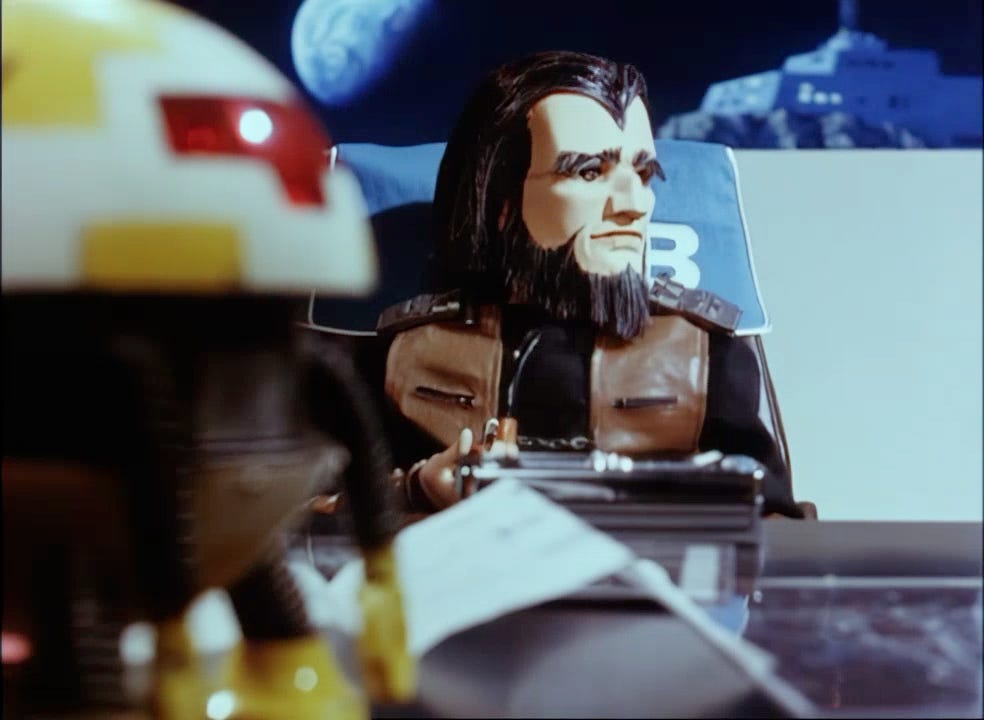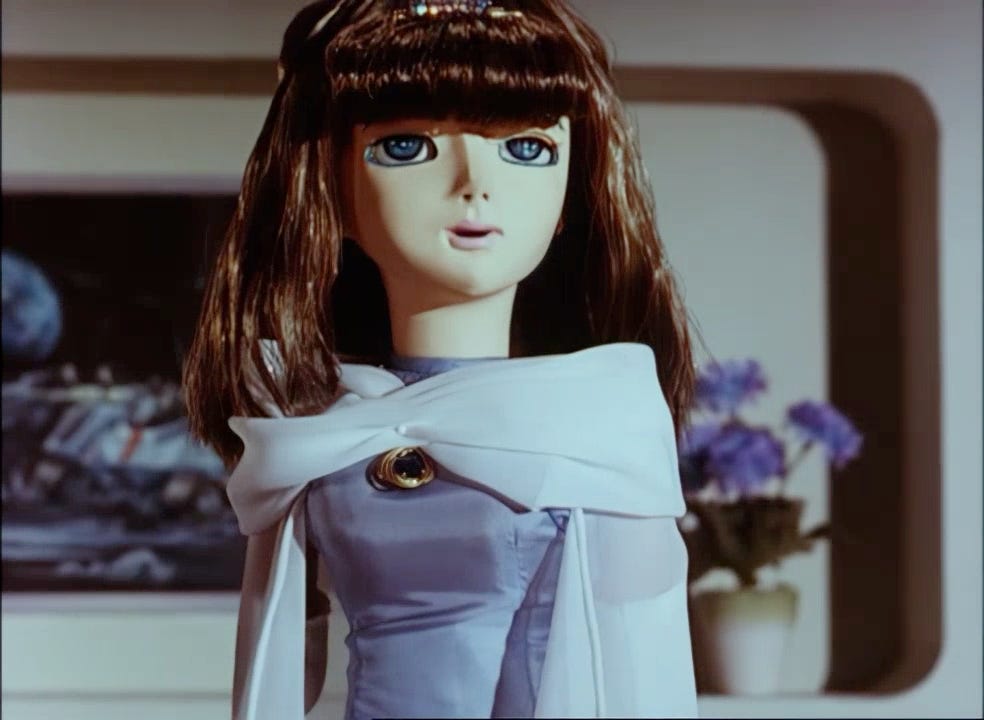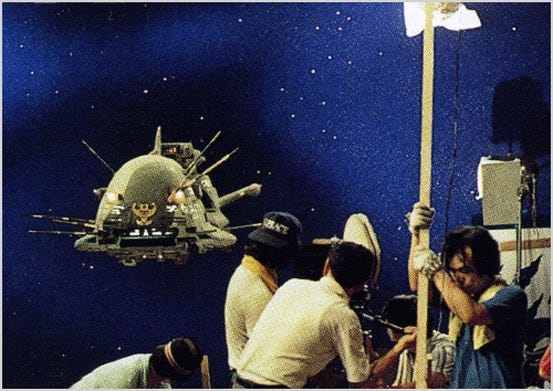It’s Saturday morning and the opening titles have just gone down a treat. I’m sure you’re wondering, what wonders await us next?
Right from the very beginning, there was something different about Star Fleet. Most kids shows would drop us right into the middle of an action sequence. There’s plenty of that to come, but for now we’re treated to a simple A chord on Paul Bliss’ majestic synth score and a view of the sun emerging from behind our home planet.
Sunrise. 1
It’s quite a beautiful and poetic way to begin. Stillness and peace in an era of ceaseless clamour and noise jockeying for the attention of kids and their parent’s wallets. Star Fleet makes a claim on that cash, but it doesn’t mind hinting that there is something deeper at play to it’s young audience.

Space, in most images, is black with occasional pinpricks of faraway stars depending on how much light pollution there is from a nearby star. Films like 2001 and Star Wars took a realistic approach while Star Fleet opts for something more stylized. The use of blue in the space backdrop is really distinctive, echoing the blue hue of shows like Thunderbirds. But this is a bit darker and richer for the post-Star Wars age.
Before we see anything, we hear the sound of a spaceship, a piece of sound design that remains throughout the entire series, signifying the presence of a huge evil battleship.
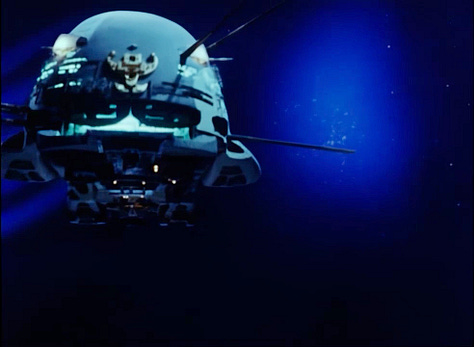
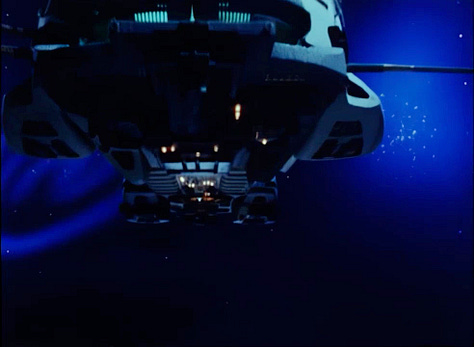
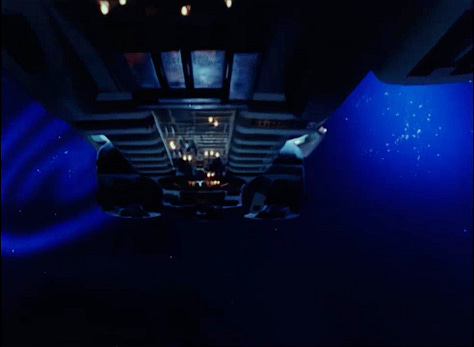
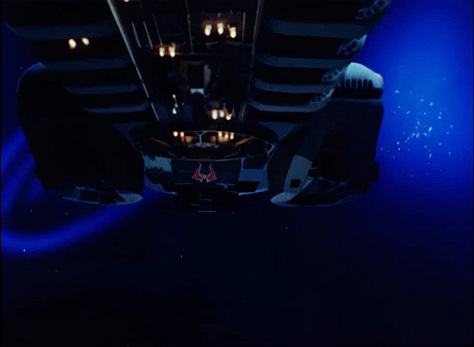

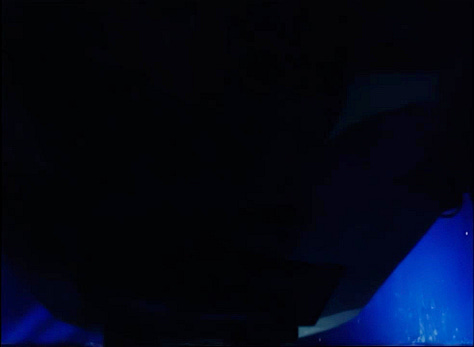
As the pan/dolly move completes, we’ve moved across the solar system to an invading battlecruiser. As in a certain other space adventure movie of the time, this spacecraft overflies the camera to give us an impressive shot of the detail that went into the model and to emphasize just how powerful and large this vessel is. It is really, really big. See the footnotes below to get an idea.
This is also the debut of bird-like insignia of the front of the vessel and an Imperial Alliance logo on the underside. More on these in due course.
As we push into the underside of the vessel, we cut to a shot of the bridge. Later events seem to indicate that this isn’t an accident and that the bridge of the ship is at the rear/center. However, the ship’s catfish-like appearance (no accident either, according the X Bomber Encyclopedia2) gives me the impression the bridge is near the front or "eyes" of the ship. Any more information on this would be very welcome!
Regardless of exactly where we are on this huge, and evidently alien, ship, we are now confronted with it’s occupants. A wall sized bronze emblem hangs at the back of the room. Green, red, and yellow textures and lights cover the walls and the foreground is covered with all sorts of objects. This is a striking set. Bold and very alien.
The characters, at first glance, are also very otherworldly. Insectoid and almost biomechanical in their appearance. With the exception of a woman at the back.
This is unlike anything you would have seen on TV in 1982, or even 2022 for that matter. She’s pale and wearing a bronze miniskirt and top that looks like Xena the warrior princess from outer space by way of ancient Rome. That thing she’s leaning on? That’s a sword. Her attire is draped in a royal purple battle cape and she’s sporting… some sort of elaborate headgear. It’s a helmet not unlike Shiro’s except for three pairs of horns, a very different colour scheme, and cutaway section that features lots of exposed wiring. An eyepatch in the shape of a face leers over her left eye and her right blazes with the same fiery red as her hair.
This ain’t your daddy’s Thunderbirds, kids.
In the first words of the show, we hear the magnificent voice of Denise Bryer, a Gerry Anderson veteran who also provided voices for classics like Labyrinth and Return to Oz. She calls for a subordinate, Orion.

Orion is not exactly a handsome bloke. He’s less humanoid than Makara and much more insect-like. His eyepatch is similar to hers but designed to fit into a caterpillar design on his Stahlhelm. His eyes and hair are more yellow and he wears a less regal green velvet cape. His armour is painted to look more like steel than bronze and also features the biomechanoid tropes. These puppets are brilliantly sculpted and so far very skillfully operated.
Right away, there is a double act between these two characters. Makara is clearly in command as she orders him to slow the ship from 10 parsecs.3 We've exited somewhere called the "Thalian Zone." Orion puts on the brakes to pull us out of hyperspeed.
Makara has a different take on the peaceful scene that opens the episode. She sees this as an opportunity for conquest. Her first target? Earth.
Interestingly, she refers to her location as the galaxy, not the solar system, perhaps implying she came from someplace a lot further away? As mentioned last week, it’s probably best not to worry about it since the nomenclature shifts frequently.
Orion snivels and kisses up to his mistress, introducing us to the catchphrase “by your divine guidance.” This implies an ancient Egyptian approach to government where the hierarchy was thought to be appointed by God, and the top theocrats were reckoned to be gods in and of themselves.
Despite the gods being on her side, Makara isn’t about to let her guard down. She warns Orion to keep a look out for enemies. Orion orders “full quantum speed ahead” which could be an equivalent to Star Trek’s impulse power. Interestingly, he refers to enemy ships as “star fleet cruisers.” Later events seem to indicate that this is the first encounter with Earth, but Orion already knows what he’s looking for. Although, this might just be to clue in the audience.
The insectoid creatures, beautifully sculpted and wired to speak with flashing read eyes, use an electrically altered dialect.
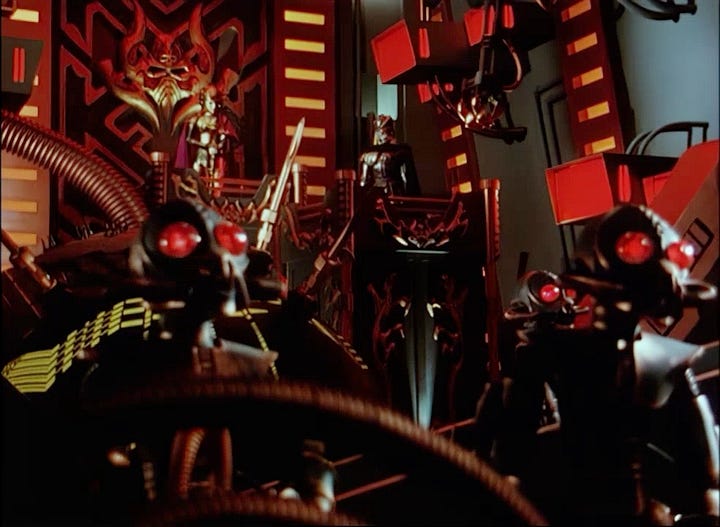
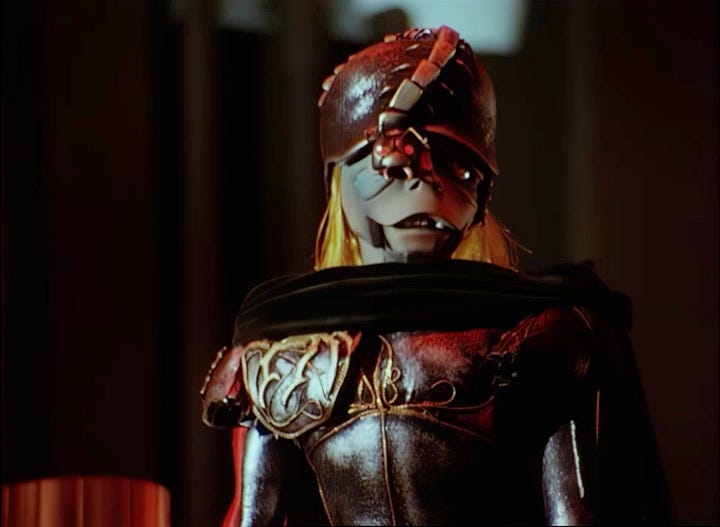
We get another wide shot of this big, bad, battleship and it doesn’t take long before these villains detect an approaching vessel. When Makara inquires about the incoming vessel’s speed, there’s a slight goof in that the electronic effect applied to the voice of the insectoids (usually referred to by fans, and henceforward by me, as termoids) is accidentally placed over the voice of Makara. I initially thought this was an intentional indicator of her method of communicating directly with the troops, but it’s never repeated. It just goes to show that the English dubbing sessions were likely conducted in a short span of time and at a frantic pace. We’re only two and a half minutes into the episode’s run time and we’ve already introduced a lot of concepts in the dialogue. But we’re about to get even more.
As Makara orders the unprovoked attack, a voice calls out ordering her to wait. Crash zoom to the thing on her face. Is that where that voice is coming from? Nope, this thing’s eyes start to glow and it begins to speak in a totally different voice. What?
Anyway, it responds subserviently to the voice which it identifies as “Imperial Master.” The sort of name you would pick for a D&D forum back in the day.
A hologram of the Imperial Master pops up. This dude is big and evil looking with a rectangular black robe and bones making up his helmet. We can’t see him too clearly through the lines in the transmission, but we get the message. There’s something more to this mission than simple conquest. The oncoming storm Earth is about to face is in service of some sort of higher purpose. This is the foundation for a story arc that will carry us through the whole series.
Makara swears fealty through her symbiotic, masculine eye patch. Clearly, Makara is a powerful female figure, completely in command of her ship. Yet, her boss is male and here she only speaks to him through a male alter ego, or male aspect of herself. The gender roles of villains in anime were much more fluid than in Western cartoons, most notably with the hermaphroditic Zoltar in Gatchaman. Zoltar’s gender shifting abilities were mostly edited out of the English language version, Battle of the Planets. It’s possible something similar is going on here, but the filmmakers don’t expand much on this theme.
Having said what could’ve been an email, the Imperial Master bugs off. Makara launches into jargon about “laser torpedos” and “cluster assaults” for “maximum penetration.” The gist? Destroy that spaceship.
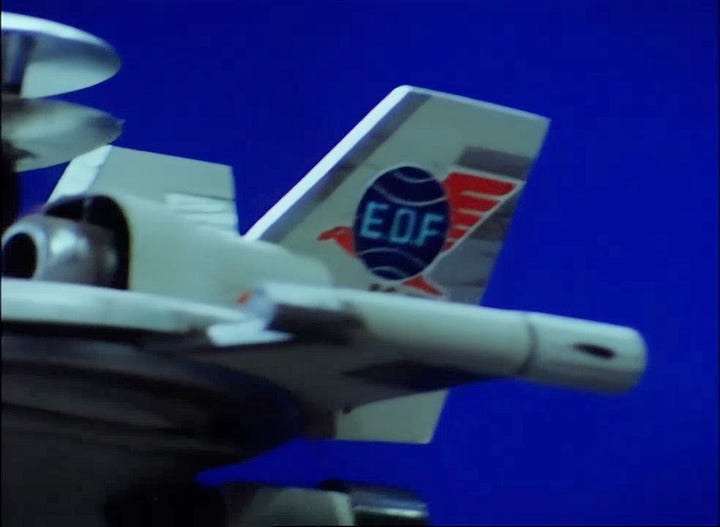
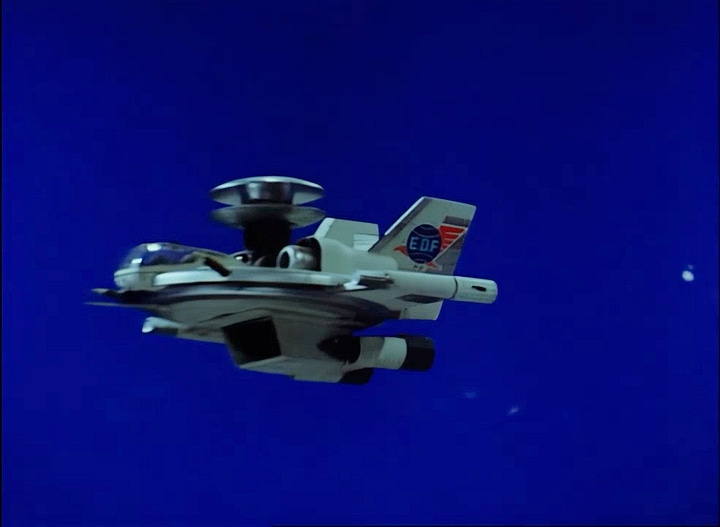
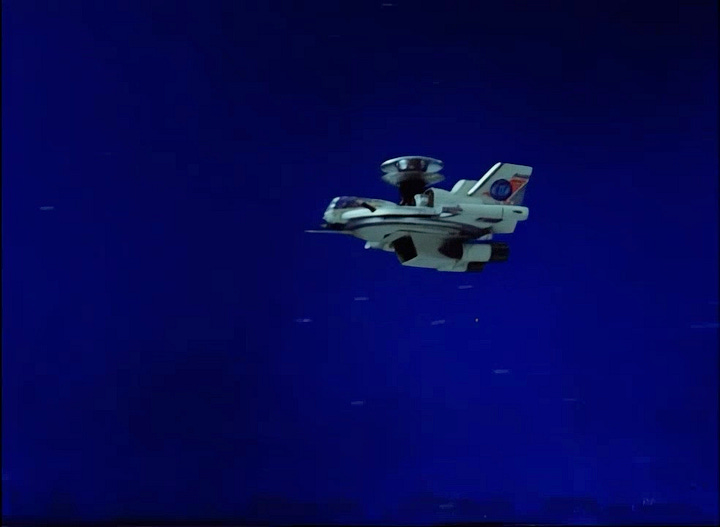
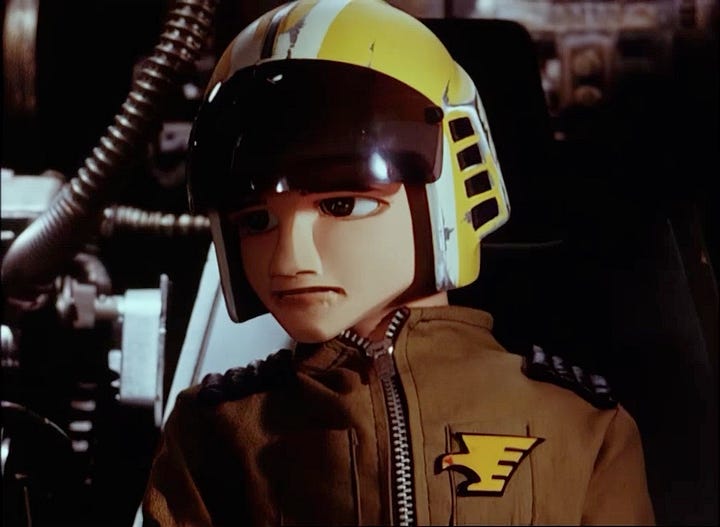
Remeber the EDF logo from the opening titles? Well, it’s back and this time on the fin of a spaceship. This looks like a ship out on patrol to gather data, based on the presence of a large radar dish on top of it. There is a little laser canon-looking weapon, but it could be a scientific instrument.
I actually think this ship is a brilliant bit of design. Like the starship Enterprise (flying saucer and cigar shaped spaceship) it takes two familiar ideas and fuses them in a novel and interesting way. Here, a basic flying saucer shape is slapped into the middle of a jet fighter. It’s got lovely air scoops on the top and bottom. Why are they there in space where there is no air? They’re gathering particles and data. Also they look cool.
The first victim of the Imperial Alliance’s attack on Earth is this guy in what could easily be another version of the generic cockpit sets seen throughout Star Fleet. He’s got a sweet yellow helmet that I’m definitely jealous of and an eagle insignia on his light brown uniform. He is understandably taken aback by the presence of an alien spaceship in the vicinity.
He reports it to Pluto Base, identifying himself as Star Fleet Cruiser 1 and the UFO as a “warship.” He knows they’re coming in from the Thalian Zone and a guy on the radio tells him to establish their ID.
These space action shots have a shaky, almost handheld quality totally missing from Western science fiction films. While some might feel it makes the series look cheap, I think it’s a forerunner to the kind of realism that would become prevalent in the early 2000s with shows like Battlestar Galactica and Firefly, who would artificially add camera shake to special effects shots in order to give them a greater sense of urgency.
Commander Makara orders the spaceship destroyed before a single transmission has been received. Orion and company are all too happy to comply.
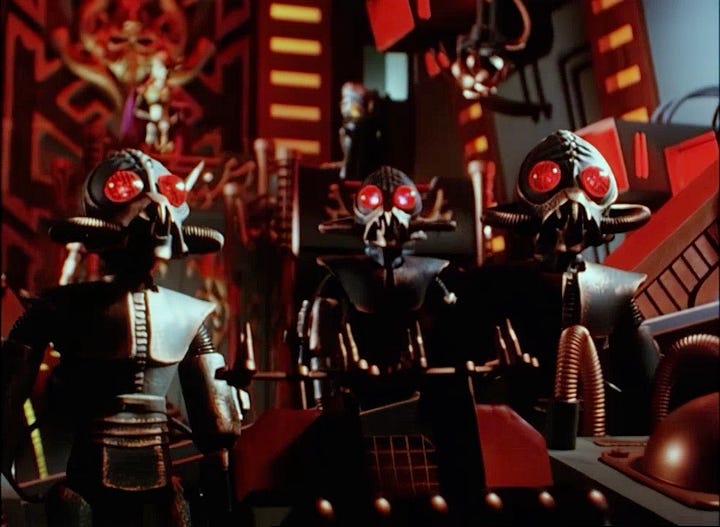

Having provoked a war, Makara’s ship thrums menacingly toward the camera. They made that cruiser into dust in a matter of mere seconds. What could possibly stop an enemy of this incredible power?
Back on Earth, we get some narration courtesy of the brilliant Peter Marinker– a highly distinctive Canadian voice actor who’s had a very long career. We learn it is 2999, “Space War III” is over, and at last there is some peace and quiet around here.
We are then treated to a lovely matte painting of a city on Earth in 2999. Since the series mostly takes place in space, it is nice to get a bird’s eye view of what life might have looked like here.

Earth, like Japan in the 50s and 60s, is rebuilding a peaceful new future “out of the ashes of devastation,” the narrator explains. Star fleet, who call this place their home and HQ, are the new peacekeepers, with a view of themselves as part of a united solar system.
Wow! I’m not sure how big this set is (the puppets are about 500 to 600 mm tall so roughly 1/3 scale) but the filmmakers do a great job of making it feel vast by using extras in the mid ground to convey a sense of activity and by using tiny figures for a forced perspective effect to make the room appear much bigger than it probably was.
The design of this room is very slick and 80s and almost a forerunner of Star Trek: TNG with smoother, rounded edges on everything. There’s lots of blue and green displays everywhere plus a huge map of the solar system that’s great for giving the audience the layout of the action, but likely wouldn’t be of any use in real life.
Someone called Captain Carter is calling and the two unnamed subordinates who salute very rudely in the opening titles (referred to here as Number One: the red head and Number Two: white hair and mustache) take the call thanks to two speaking extras with intense expressions.
Carter is top brass at Star Fleet’s Pluto Base and he’s voiced by Star Wars veteran Garrick Hagon, a remarkable talent and familiar face/voice in film and TV for decades. He brings a lot of gravitas to the role.
Clad in trademark sunglasses, beret, and uniform, Carter wastes no time with pleasantries. He gives a “star time” and reports the incident with Star Fleet Cruiser 1. “No warning, no provocation, no survivors.” It’s unclear how many could have been aboard Cruiser 1. The cockpit seemed cramped, but this comment seems to indicate there might’ve been a survey team aboard.
Number One needs to know what Captain Carter is going to do. Carter gamely announces his intention to scramble all fighters immediately. Here, the limitations of the puppets begin to show. Number one has a rigid face that can’t truly express his astonishment. Unlike the Supermarionation puppets from England, he doesn’t have a head with an alternative to his regular expression (although some characters will later). Cameraman Ryuji Kawasaki does his best to create the appearance of anxiety by showing the whites of the eyes from a low angle, which just about provides the illusion and provides one of the earliest examples of Star Fleet using cinematic technique to enhance and aid the performances of the puppeteers.
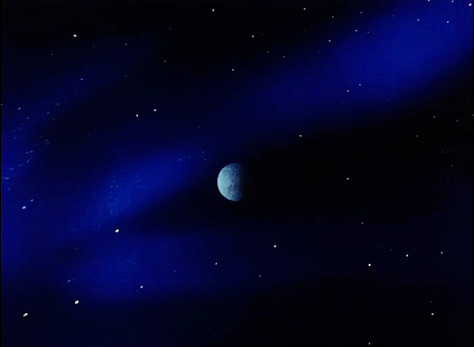
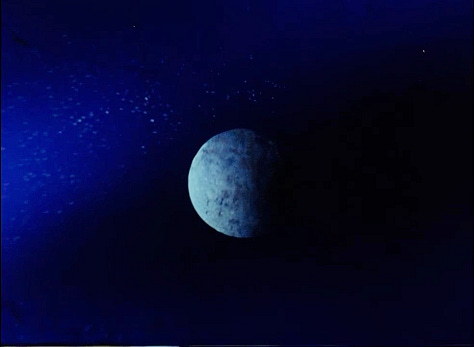
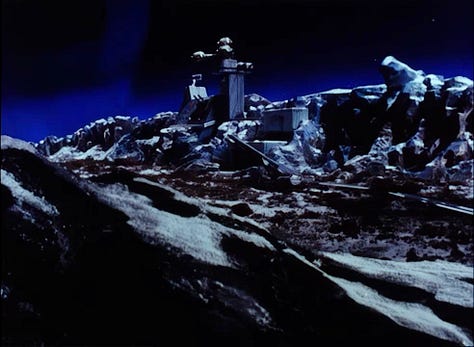
In case you were wondering “what about Pluto?” or “is Pluto considered a planet in the 30th century?” We now get to take a visit to Pluto. That last question isn’t answered directly, but it seems from the narration that Pluto is the front lines of the solar system’s defenses. I wonder, was Space War III entirely confined to solar combatants or were there extraterrestrials involved there as well? Star Fleet has all the hallmarks of a first contact story and none of the history of who was fighting who in the last war. Suffice it to say, this is Pluto “Alpha” Base and, as in shows like Captain Scarlet and UFO, a whole plan to protect the system from extraterrestrials is already in place, even though there may have been no indication of their existence before now.
Synth drums pound on the soundtrack. Peter Marinker is back to let us know where we are. There’s a lovely shot of the base. Although Star Fleet was a low budget show, every effort has been made to create a whole world for the audience to enjoy.

These EDF fighters keep the flying saucer/jet fighter theme going. This is a great looking shot with lots of depth and realistic lighting. It’s like being in an aircraft hanger just before the planes take off. Quite a lot of fighters here too!
Captain Carter orders the doors opened, and we’re off!
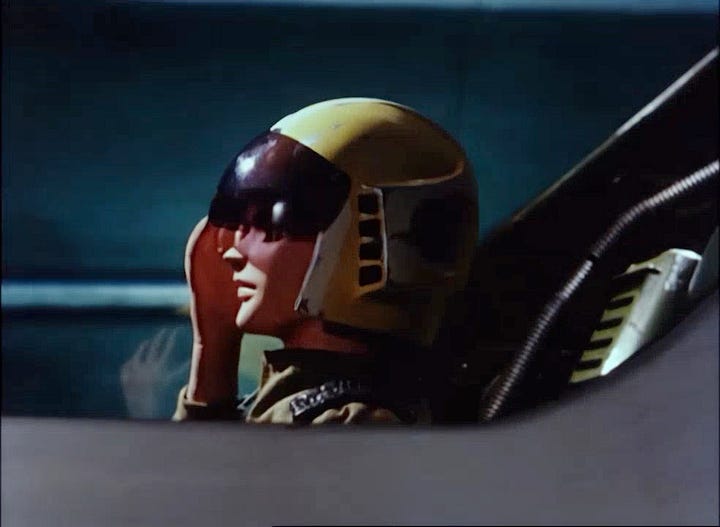
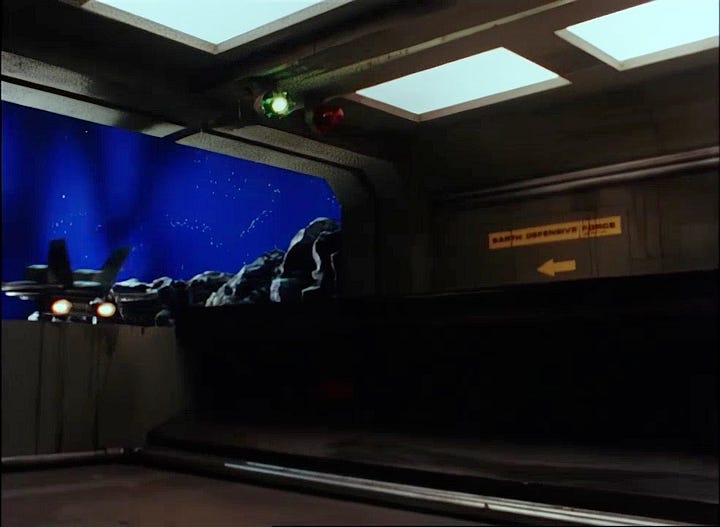
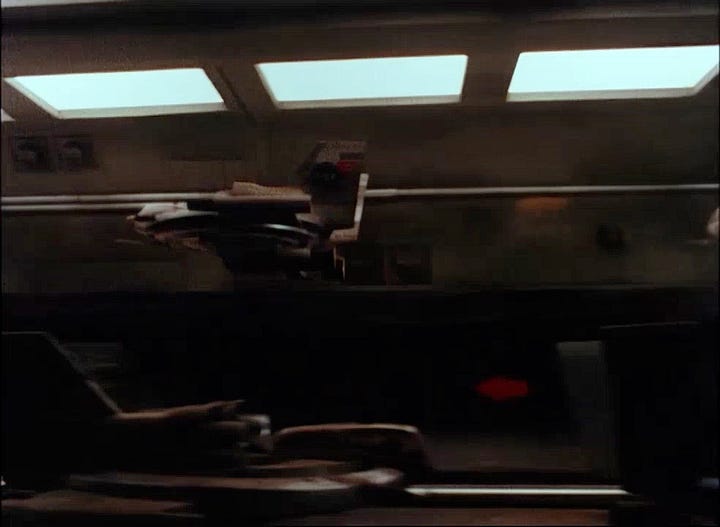
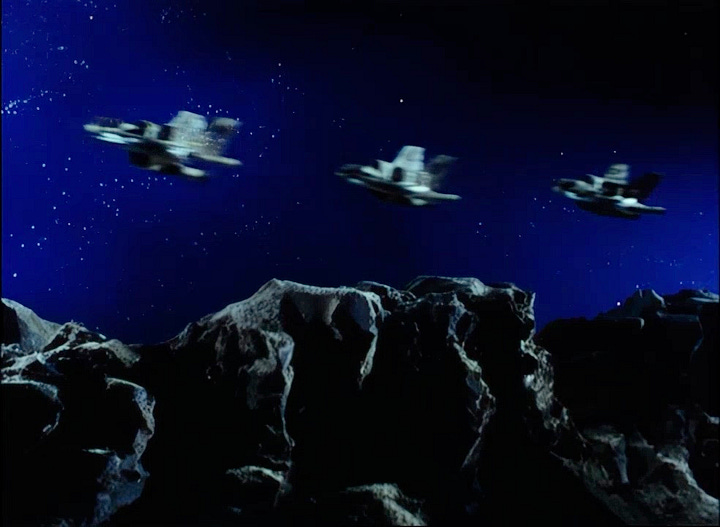
Astro Fighter One has a launch signal (voiced by someone in the cast, my guess would be Constantine Gregory) and the others follow in rapid succession. From here, the pace increases to an impossible speed.
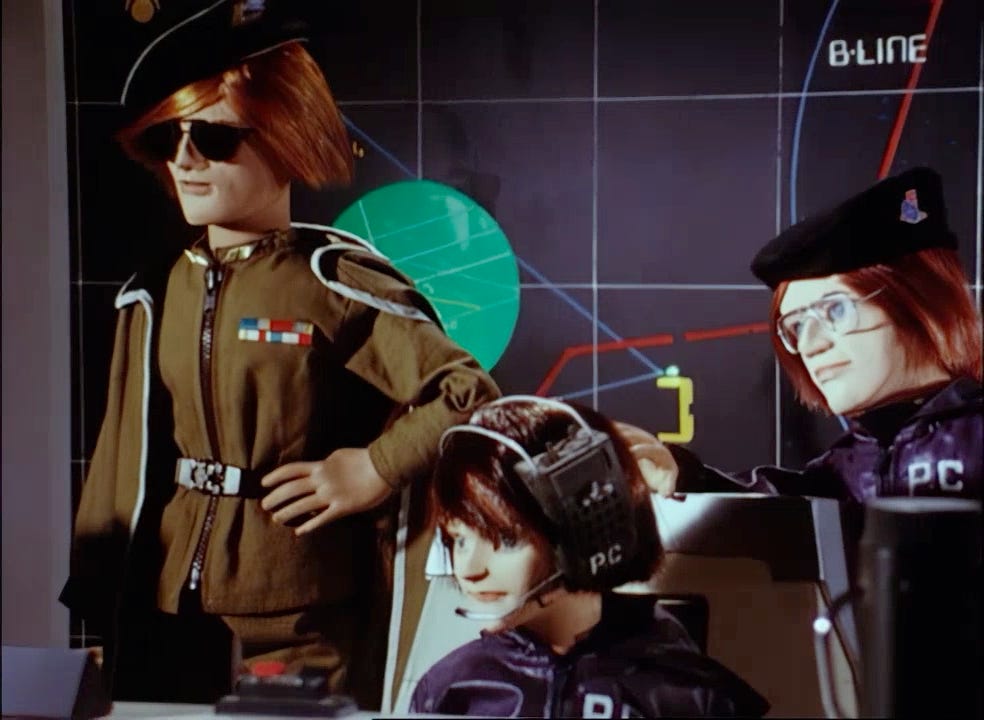
Captain Carter tells his subordinates that the alien craft has to be destroyed “before it penetrates our defences.” Nobody bothers to discuss communication. Which seems to be Makara’s mode as well.
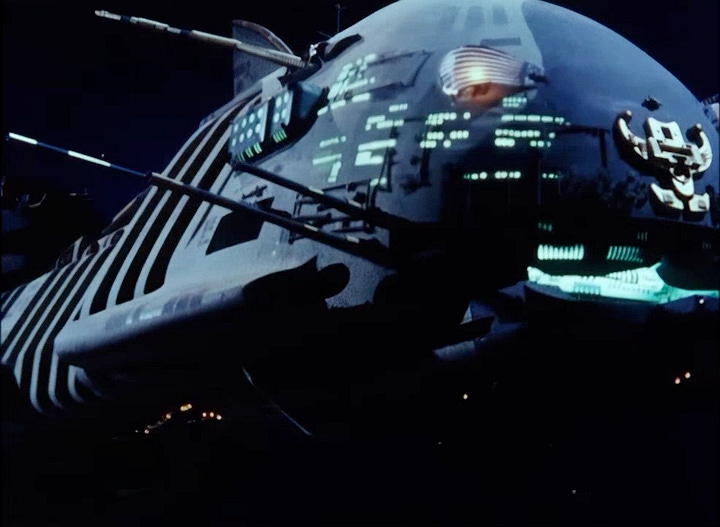
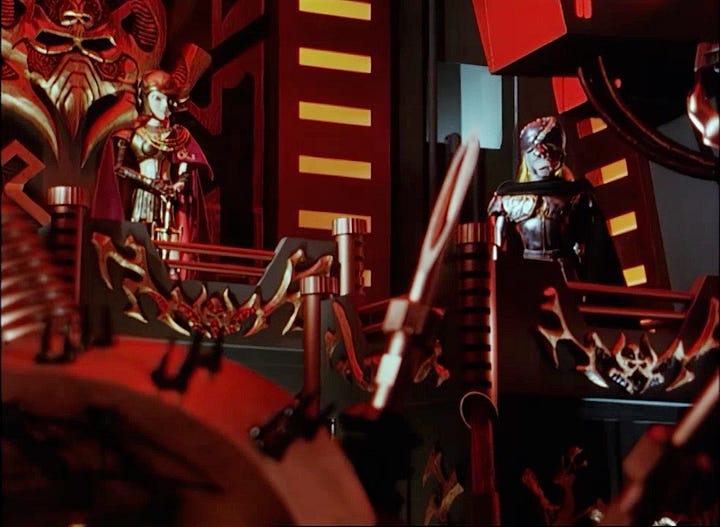
With a bit too much glee, Makara orders Orion to annihilate the EDF fighters. He proceeds to do just that!
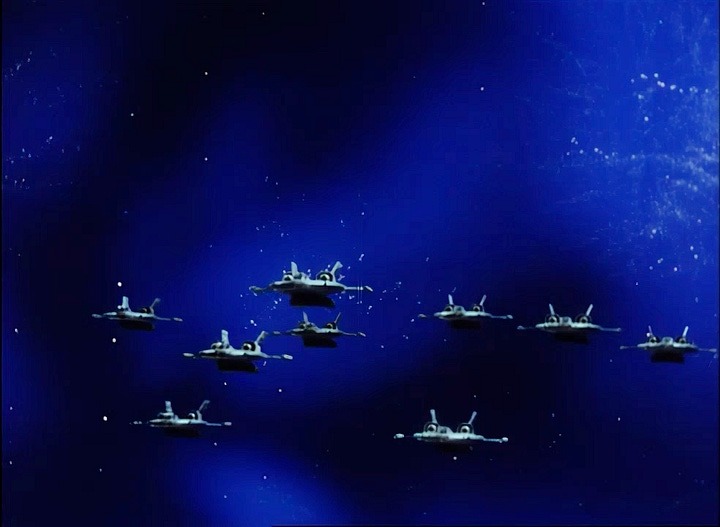

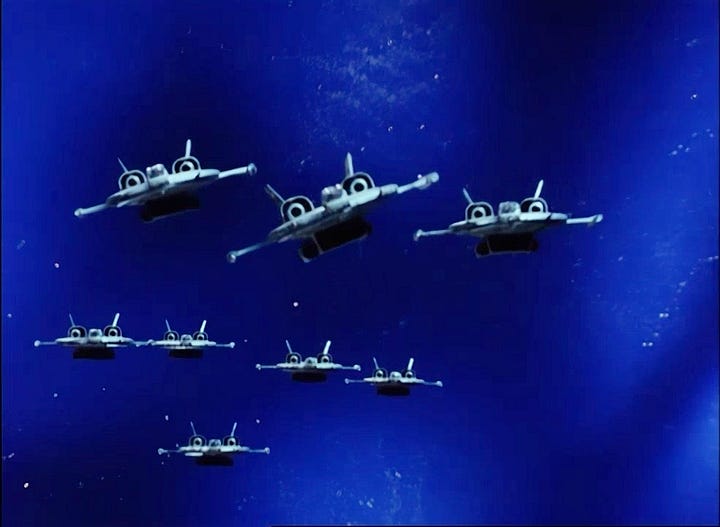
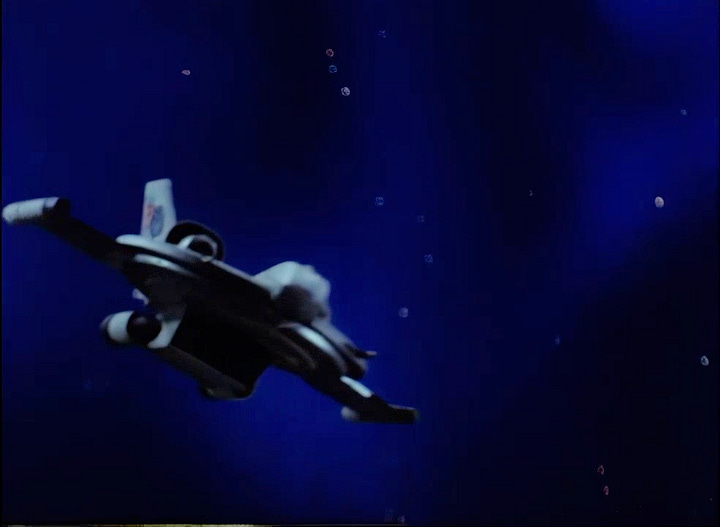
A guy we can only assume is the squad leader promises a “laser torpedo” show for the “uninvited guest.” These puppets are more caricatured than the Thunderbirds puppets, as you can plainly see from this guy’s chin.
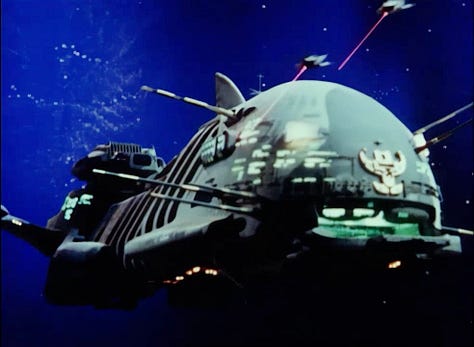
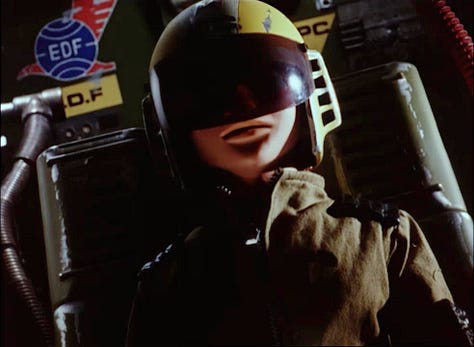
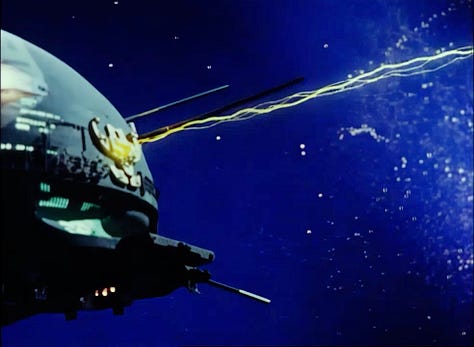
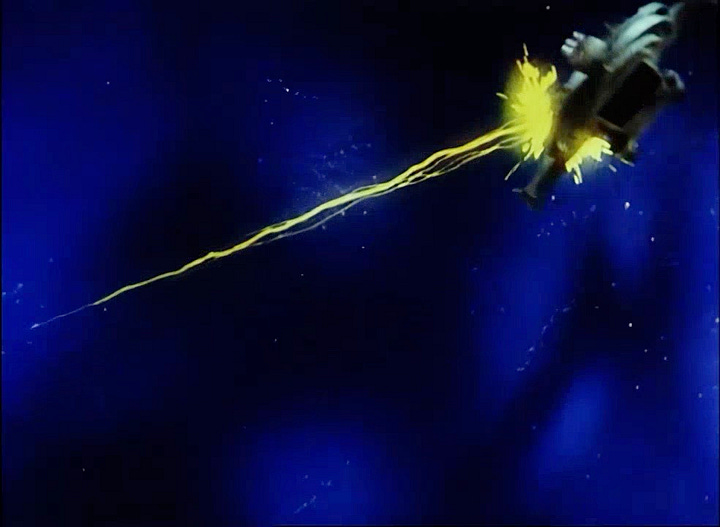

The EDF pilots get in the first few shots, but there’s no effect. Meanwhile, Makara’s ship fires it’s weapon once and the pilot is toast. This might not go so well.
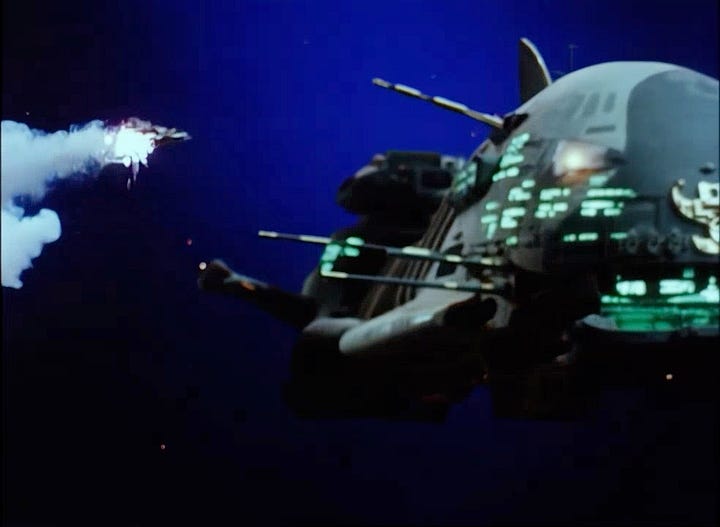
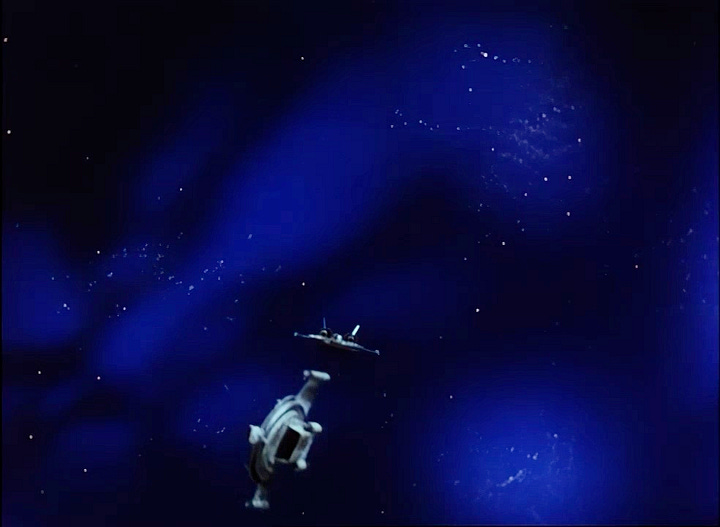
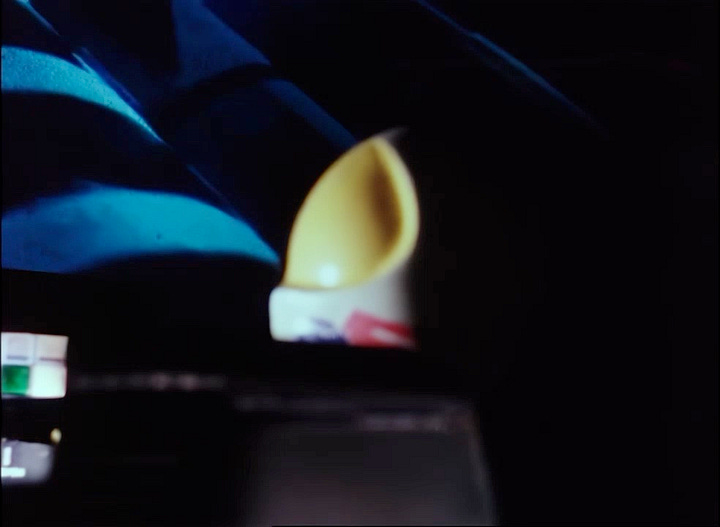
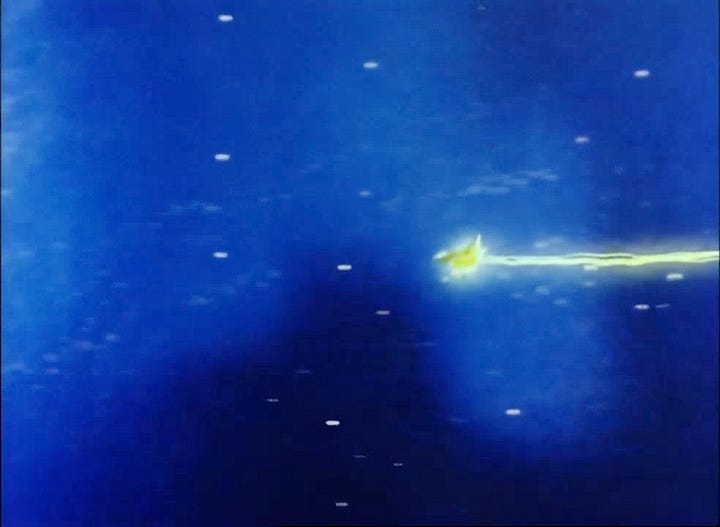
A brave pilot goes in for a strafing run, only to be cut down. These are some lovely shots, especially the over the shoulder view of the pilot in the cockpit as he makes his attack. This looks like a bit of model footage projected onto a screen rather than an optical printing composition.
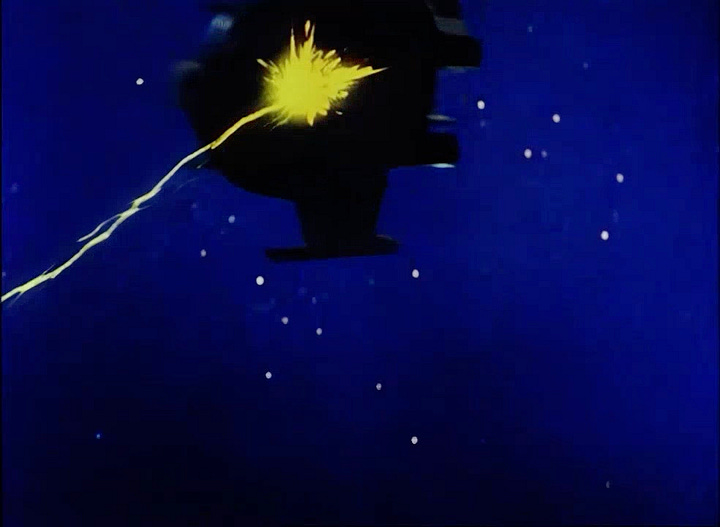
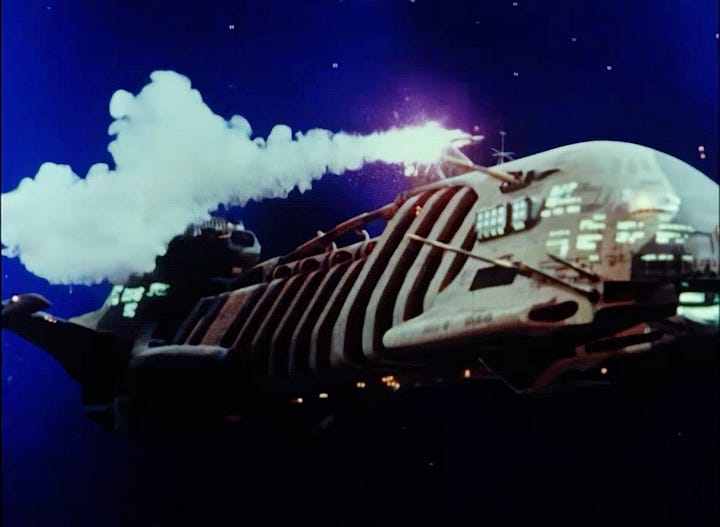
The explosions in Star Fleet are more smoke than fire. They also tend to show the effects of the studio gravity (debris falls down rather than flying out as it would in space) but they are cut together quickly and they have a reckless, practical aura that makes them feel exciting and dangerous.
Makara destroys the whole fleet. All those fighters? They are decimated to the wailing synths of Paul Bliss.
At EDF HQ, some flashing red arrows point at Pluto on the giant board, indicating invasion. Good thing they were invaded or the designer of that bespoke board might have felt a bit useless.
Number One and Number Two are looking nervous, when the General enters demanding the latest report.
The General enters very stiffly. He basically swings his shoulders, rather than walking and there isn’t a great sense of gravity. Not sure why this shot was picked to open the show every week. It’s not even the best shot of this character, who actually has great presence and a great voice from Kevin Brennan.
He wants to know the outcome of the battle and number one is the lucky guy who gets to break the news. Plus, we get that saluting shot as everybody hems and haws before finally spilling the beans.
General Kyle is incredulous about the defeat, but quickly concludes invasion is imminent. Number Two interjects that there isn’t time to assemble “ocean fleet.” It isn’t explained what this is (at this point) and why it would take so much time to assemble. Captain Carter scrambled to action pretty damn fast. Of course, given Makara’s firepower I doubt that fleet would do any good. But something like an X project on moon base might…
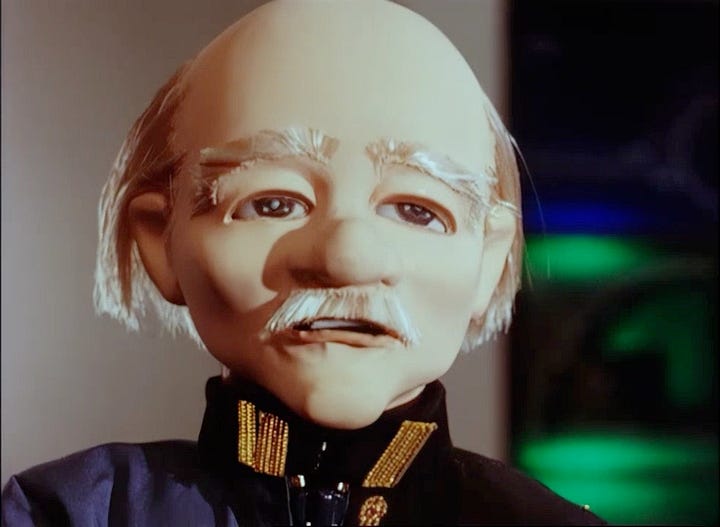
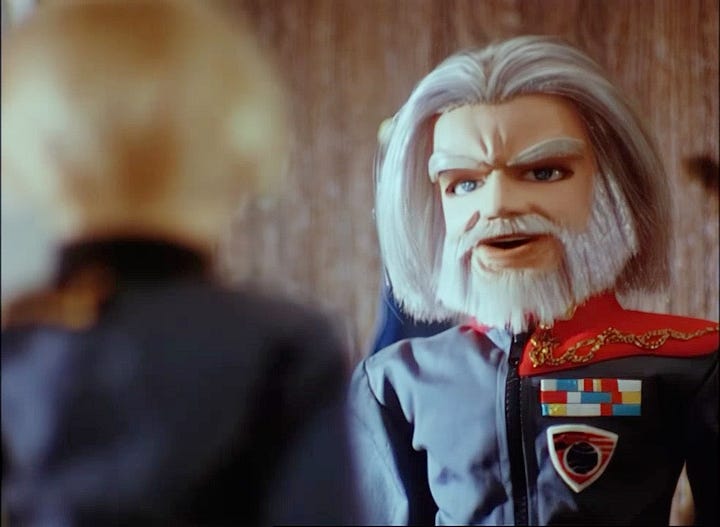
Wait, who’s this? Dr. Benn at moon base? What a handsome guy. And that voice? It could only be Peter Marinker.
Benn and Kyle begin to chat like old friends in bad times. Kyle wants Benn’s help, but the good Doctor claims his hands are tied.

The secret X project is the only hope, Kyle reckons. But Project X is only 90% ready. Number Two gets excited and says that’s basically done, but Benn quashes his enthusiasm. That final 10% could mean life or death for a different batch of pilots. Mysterious…
Number One makes an impassioned plea, and the Doctor consents, requesting three of the most promising pilots.
General Kyle already has three people in mind, which is a bit odd. We’re not told how big EDF is, but the scale of the place is big. For a general to keep track of all the top new pilots at “Star Fleet Training School” is pretty impressive.
Thanks and best wishes are exchanged. As Benn hangs up, the enemy warship is reported “300 militons” from Pluto. This measurement of distance appears to be made up for the show and not to be confused with the gourd of Mexican origin.
Perhaps being the best at Star Fleet Training School isn’t that hard, because General Kyle knows the full names of Cadets Shiro Hagen, Barry Hercules, and John Lee, who are to be the crew for this new project. If there was stiffer competition, maybe there would be too many qualified pilot’s names for leaders to remember. Or maybe these three really are exemplary. Let’s find out!

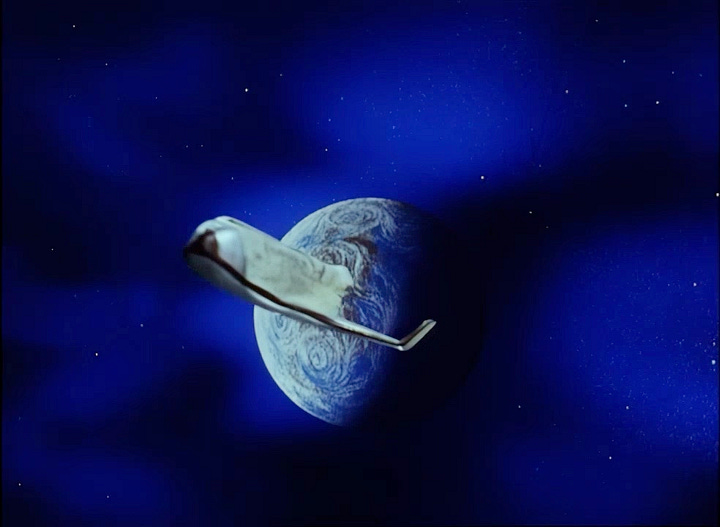
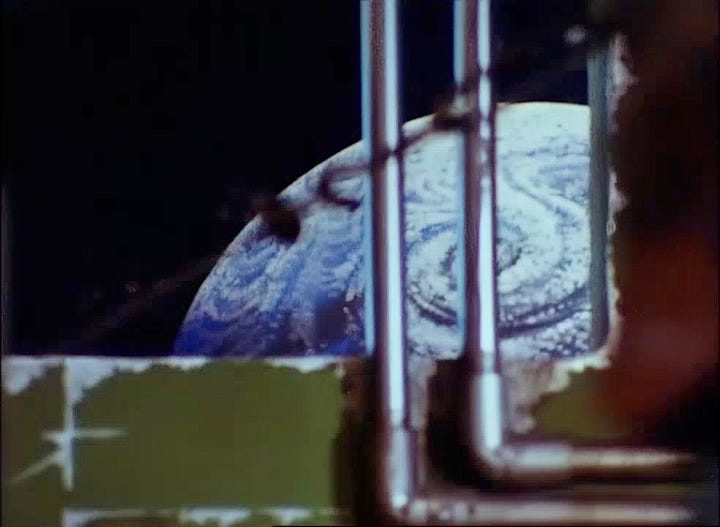
This craft feels a lot more flimsy and contemporary than the advanced fighter aircraft we saw on Pluto Base. There’s no weapons visible. Our young heroes take one last glance back, but there minds are on the mission ahead.
Meet Shiro Hagen. He’s young, handsome, and a bit brash. He’s voiced very earnestly by Jay Benedict. He’s very much clued in to some things, but not to others. For example, he knows Pluto Base is “fighting for it’s life” but has no idea why he might be headed to moon base. He’s introduced with a slick rack focus from the window, followed by a dolly move. These frequent camera moves keep the puppets looking alive and not like stiff dolls. Meanwhile, each character has been given small actions to do to keep busy.

Our heroes are in the cargo bay, with what look like rucksacks full of their possessions. Little do they know of the universe altering adventure that is about to head their way. But who does that boot belong to in the foreground?
Barry Hercules (Constantine Gregory) is on hand with a guitar. He’s not playing, he’s just holding it. He’s laid back but ready for action and clad in his trademark camo. He tells Shiro to “keep cool” and that there is a “laser fireworks show” in the future. Right on, man. Right on. Notice the bandoliers tossed over his shoulders are made out of pencil sharpeners.
John Lee is pretty stressed by all this talk of lasers and sudden death. He’s portly, a little cowardly, and generally brings balance to the team. It’s also revealed later that he has the most technical skills of anyone in the trio. If I had hair like this, I would definitely cosplay as Friar Tuck at the first opportunity. He also has no clue about this “X project.”
Through some exposition disguised as dialogue, we learn that Shiro’s father was the designer of the X project, making his lack of knowledge highly suspect. Shiro denies everything and reminds his friends that his father disappeared to the Institute of Mars and has been there “for years.” They are no longer in contact, but the tone of Shiro’s voice gives no indication that this estrangement is acrimonious.
This is intriguing stuff. Since Shiro is pretty young, his father must’ve left for pastures Martian when Shiro was still a kid, or at least a teenager. Since Pluto just phoned up Earth, there must be means of communication between planets. Something else is clearly going on. Also, it’s quite a coincidence that these two are both now linked to this mysterious “90% completed” project.
Barry muses on the mystery, mumbling “the X project” with a faraway look in his eyes as if imagining some hitherto undreamed of Utopian defense machine.
Lee reckons they will know soon and Shiro points out that they are nearing their destination.
Their pilot, unseen and voiced by a member of the cast, identifies the craft as “Star Cruiser #17.” This is clearly not the same as a “Star Fleet Cruiser” despite the similar names.
I’ll try not to gush too much over this. But. Wow. This matte painting is pretty much pure X Bomber. It decorates a lot of merch for the series, including the recent exhibition catalog and the 2003 Japanese DVD box set. It’s a lovely bit of design that looks like it could’ve come from the canvas of Chris Foss or Ron Cobb. The yellow and white color palette is in perfect balance with the blue marble of Earth and I love the airbrushed dome on the far right. Simply breathtaking.
While I am fan-girling over this art, a voice that sounds like Liza Ross informs Shiro/Hercules/Lee’s pilot that they are clear to dock.
There is lovely spacey music that is never heard again throughout the series. Paul Bliss does a great job creating an atmosphere that is both strange and inviting.
As we transition to moon base, I’m not sure why we go to a close up of this statue. It is probably meant to represent a classical Greek lunar deity like Artemis or Mene. Although Mene was the goddess most closely associated with the moon, Artemis was also goddess of the hunt, which would explain the bow and arrows. The most prominent lunar deity in Japanese culture was male. There’s also a bit of foreshadowing here as our squad of bros is about to encounter female power on a scale never before encountered by the human race. 4
How do you travel around moon base? By escalator, of course! The amount of effort that must have gone into this shot is astonishing. None of this is ever seen again outside these few seconds of screen time. Most of the puppets are redressed and recast.
The escalator is huge. There’s extras everywhere going in all directions. There’s so much to look at! A spacecraft cruises by outside the window. We’ve become inoculated to such detail in the digital age where such matters would be mere copy and paste, but this was complicated by additional layers upon layers of physical work. There is an entire matte painting out that window, not just an alternate angle of the last one we saw. Even the planet Earth does not look the same as it did in the last shot. The flowers in the vase! Plants! The green uniforms!
And what do these guys have to say about all this detail? They don’t think much of it. Shiro dismisses it with one word. “Cozy.” Hercules mutters something about plutonium mines that look friendlier. Lee, with a bizarre giggle, says “this place could make you homesick for an asteroid” as he looks out at a monorail track that apparently encircles the whole base.
Frankly, I’m not sure what this is about. It seems like the dialogue is totally at odds with the art design and the music. Paul Bliss definitely made the right choice in ignoring these words and following the blueprint of the original Japanese language programme. Clearly, moon base was meant to be home away from home, just like EDF HQ.
Dr. Benn smokes a pipe and stares down at Earth. Who knows what that wise man might be thinking? No doubt about the future of that planet, which is now in dire jeopardy.
An electronic voice interrupts his reverie. Oh my, could it be?
It could. That yellow robot. I’m just a little obsessed. Not sure why. He’s essentially the same as a hundred other R2-D2 knock offs, but something about him is really charming. Definitely not the voice, which is played as high-pitched, officious, and smug by expert actor and voice coach, John Baddeley. It’s more in his senseless flappy wings and flashing eye piece that blinks in time with his speech. He’s a very simple shape and functions very well, unlike the regular cast of puppets who have more than their fair share of malfunctions and awkward movements.
Lee, not having been introduced, wonders about the identity of this buzzy bot and Doctor Benn gives a knowing laugh.

Doctor Benn introduces himself. There is a weird pause on the soundtrack as Peter waits for the puppet’s mouth to open again mid-sentence. This is a problem that plagues Star Fleet frequently which is a result of the translated dialogue failing to match. Of course, there were much fewer resources in those days to review the film. I would assume writer Michael Sloan worked from film prints of the show, if he was able to see it at all. There would be no freeze-framing or rewinding to try and get it right. Time restrictions likely meant the voice actors had few takes. Although sometimes I find it distracting, I think this subtle awkwardness adds to Star Fleet’s charm. An artifact of a bygone age like the dubbing in a Godzilla film or an Italian giallo horror spectacle.
Our heroes perform their own introductions in footage that was lifted to create the opening titles. Doctor Benn is very friendly, with cries of “let’s get to know one another!” and “hope you like it here!” Only to turn frosty when Hercules sticks his foot in his mouth and calls him “Doc” instead of Doctor. Whoops. 5
As Lee makes a squirming noise at Hercules’ faux pas, the camera pans across the three of them sitting at a conference table. More introductions are in order. All the seats have blue “MB” covers that must mean no one has to dust.
If you weren’t annoyed before, you will be once you learn that this guy’s name is PPA and it stands for Perfectly Programmed Android. Not only is he far from perfect, he also has the syllables ‘pee-pee’ in his name. Perhaps we’ve gone too far. There’s still something about his design though… Perhaps I secretly wish to be a flying, know-it-all robot?
Doctor Benn explains that PPA knows the answers to all their questions. Presumably, this includes such matters as “why hasn’t my father called me in years?” and “what did he have to do with this top secret military project?” but no one is given a chance to raise these points yet.
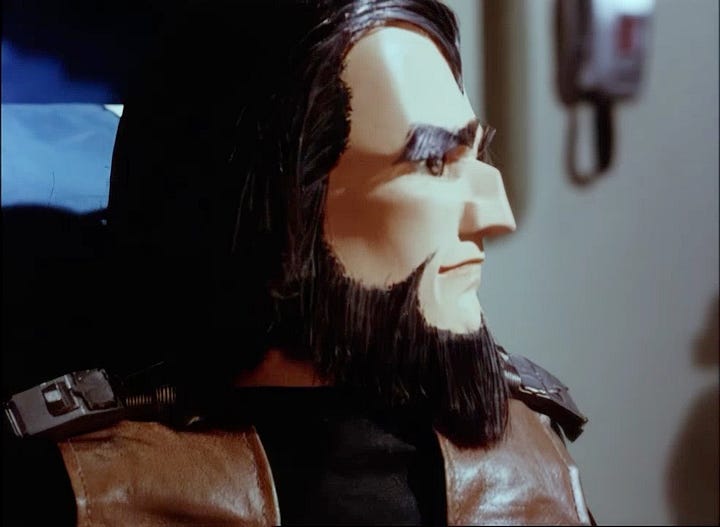
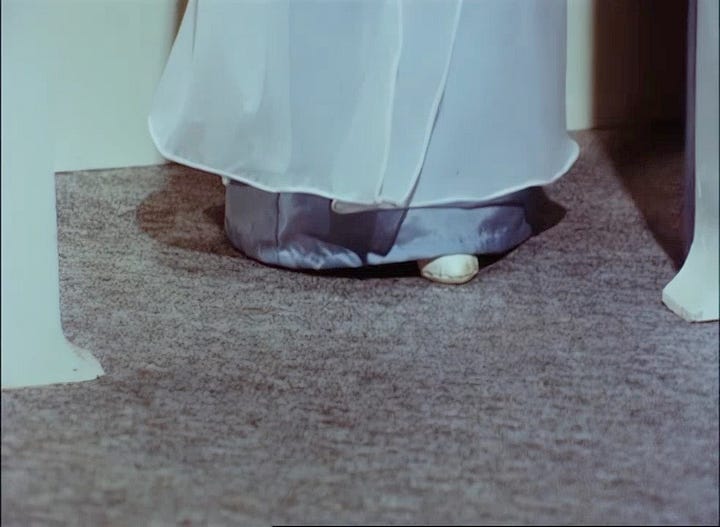
Doctor Benn calls out to someone named “Lamia” who he has apparently been keeping hidden away in a closet waiting for her cue to enter.
The door opens and the soundtrack swells with a romantic theme as a pair of slippers shuffle in.
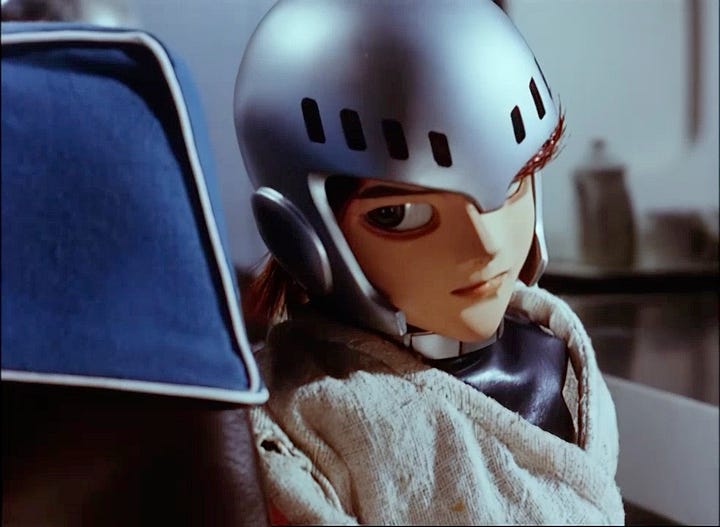
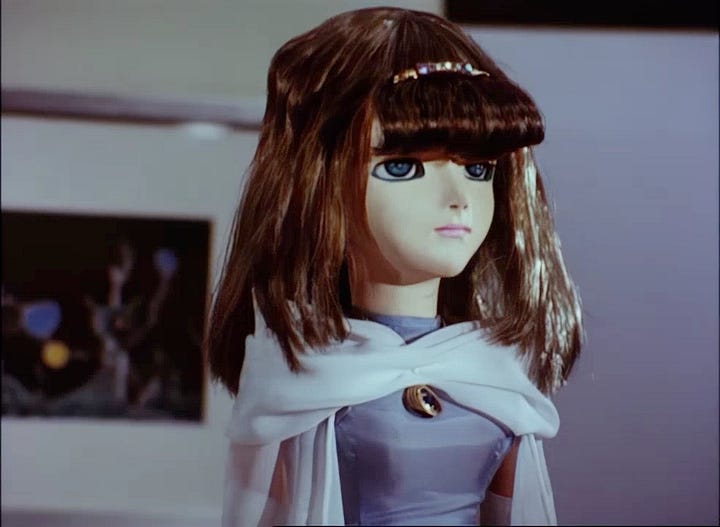
Shiro leers over his shoulder as the door closes and he catches his first glimpse of LAMIA. White gloved, blue gowned, Artemis of moon base.
After she gives the newcomers a courtly nod, they reciprocate by very openly expressing their admiration for this burnette beauty. As puppets go, this is one of the more attractive attempts out there, but nothing that would justify such inappropriate commentary as “oh baby wow,” “is it unmanly to faint,” and most incredibly of all (in the Star Fleet line most likely to never be repeated in a contemporary kids TV series) “use your radar on me anytime!” Said in response to Doctor Benn’s explanation that Lamia is in charge of moon base radar.
Doctor Benn elaborates that she is also his secretary. The boys are clearly instantly smitten with her. Particularly Shiro, who reacts like he’s never seen a woman before. He does pull himself together enough to make a polite greeting, before being confronted with the ultimate cold shower.
To keep things under control, Lamia has a personal bodyguard. PPA explains that it is called Kirara and nothing else is explained. Although clearly startled, Shiro and co don’t ask about Kirara’s origin and don’t seem bothered too much by his alien appearance and guttural grunts.
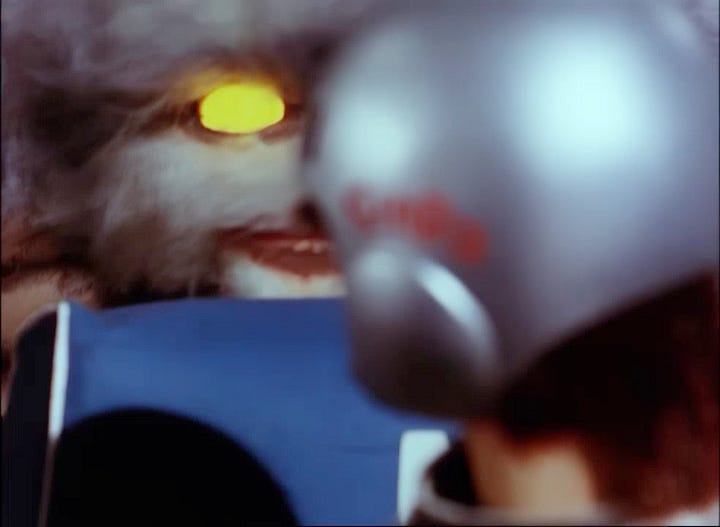
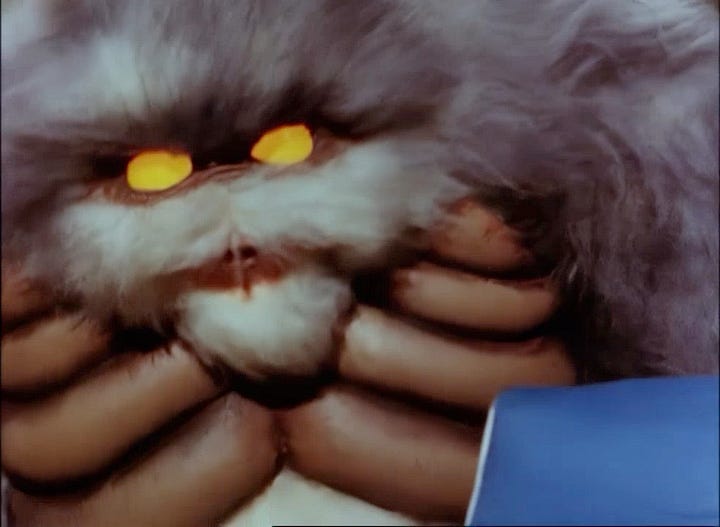
Having been confronted by a huge, hulking alien being with glowing yellow eyes, Hercules does just what any well trained space pilot would do and ignores it. His indifference lends credence to the notion that humans have encountered alien life before, possibly in Space War III.
The only thing on his mind is the X project they have all assembled to discuss. But Doctor Benn is still not ready to divulge any information….
Stay tuned for part two next week!
I believe this effect is achieved by shooting against the huge star backing that seems to have been created for this production (from the few behind the scenes stills that exist) and slowly dimming up the lights. The camera would need to be on a dolly and a lamp (a 1,000 watt fresnel, or bigger) would need to be on a rolling stand, probably draped in black. On cue, a technician rolls the stand out from behind the planet with the light pointed directly at the camera to create the flare. The dolly grip begins a move to camera left as the technician carefully manuevers the light around in the same direction, using flags to block light from hitting the backdrop. As the camera moves away from Earth and across the solar system, other lights are dimmed up to reveal more of the backing
https://xbomber.co.uk/?dir=Star%20Fleet/Articles%20and%20Scans/X%20Bomber%20Encyclopedia
What exactly is a parsec? This was a big point of contention for Carl Sagan, who objected strongly to the use of the term in Star Wars. For our purposes here, it isn’t clear if Makara is referring to distance or speed.
Female deities are typically associated with the moon because of the monthly menstrual cycle. It’s also appropriate that Lamia hangs out around here, having something of a divine, female power herself.
It occurred to me while rewatching this that this might have been a racial slight since Hercules is the only one given a reprimand. There is a bit of an adversarial tone between Hercules and the “Doc” but this is really more personality driven. Hercules is a man of action while the Doctor is more meditative. Thus, I think we can bury the topic of racism and file this incident under “let’s not overthink this.”







